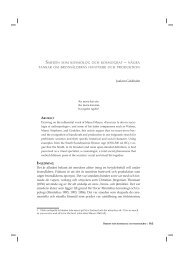rock art studies in northernmost europe, 2000 - Joakim Goldhahn
rock art studies in northernmost europe, 2000 - Joakim Goldhahn
rock art studies in northernmost europe, 2000 - Joakim Goldhahn
You also want an ePaper? Increase the reach of your titles
YUMPU automatically turns print PDFs into web optimized ePapers that Google loves.
Fig. 2.4. The famous <strong>rock</strong> <strong>art</strong> panel from Bedol<strong>in</strong>a <strong>in</strong><br />
Valcamonica documented by video-scann<strong>in</strong>g techniques (after<br />
<strong>Goldhahn</strong> 2006).<br />
Another important contribution to this field has been<br />
made <strong>in</strong> Värmland <strong>in</strong> Midwest Sweden, where Heimann<br />
has documented the Neolithic <strong>rock</strong> pa<strong>in</strong>t<strong>in</strong>gs for his PhD<br />
(Heimann 2005).<br />
Add<strong>in</strong>g to these vast new sources of <strong>in</strong>formation are some<br />
<strong>in</strong>terest<strong>in</strong>g new <strong>rock</strong> <strong>art</strong> panels found <strong>in</strong> the <strong>northernmost</strong><br />
p<strong>art</strong> of Sweden (Mulk and Bayliss-Smith 2001, 2006;<br />
Kivikäs 2003; L<strong>in</strong>dgren 2004; Viklund 2004; Broström<br />
2005), Dalsland (Andersson 2003, 2005), Bohuslän<br />
(Andersson and Toreld 2003), Östergötland (Broström et<br />
al 2005) <strong>in</strong> Sweden, Jong <strong>in</strong> Akershus (Simonsen and Vogt<br />
2005), and on Lofoten (Bertelsen and Nielssen 2002) <strong>in</strong><br />
Norway.<br />
A positive trend is that a lot of new techniques have<br />
been <strong>in</strong>troduced <strong>in</strong>to the work of documentation which<br />
may alter our understand<strong>in</strong>g of this phenomenon, such<br />
as digital photos to record <strong>rock</strong> pa<strong>in</strong>t<strong>in</strong>gs (Kivikäs <strong>2000</strong>,<br />
2003, 2005; Ramqvist 2002b; Sl<strong>in</strong>n<strong>in</strong>g 2002) and video<br />
scann<strong>in</strong>g for the documentation of engrav<strong>in</strong>gs (Johansson<br />
and Magnusson 2004, also Simson et al. 2004; Tr<strong>in</strong>ks et al.<br />
2005) (Fig. 2.4). Also the techniques of trac<strong>in</strong>g and rubb<strong>in</strong>g<br />
have been improved by add<strong>in</strong>g the depth of the engrav<strong>in</strong>gs<br />
<strong>in</strong> the f<strong>in</strong>al document (Fig. 2.5, also Coles 2001b, 2003b,<br />
2005a).<br />
More importantly, different problems and possibilities<br />
with different methods have been discussed (e.g. Bertilsson<br />
and Magnusson <strong>2000</strong>; Coles <strong>2000</strong>, 2005a; Nordbladh <strong>2000</strong>,<br />
2004a, 2004b; Bertilsson and Fredell 2003; Bengtsson<br />
2004a; Helskog 2004; Helskog and Høgtun 2004; <strong>Goldhahn</strong><br />
2005b).<br />
Despite all these progressive improvements I th<strong>in</strong>k<br />
2. Rock Art Studies <strong>in</strong> Northernmost Europe, <strong>2000</strong>–2004 25<br />
Fig. 2.5. A section of the famous “Skomakaren” panel at<br />
Backa <strong>in</strong> Brastad, Bohuslän, <strong>in</strong> Sweden, documented so that<br />
a tentative depth of the engrav<strong>in</strong>gs is shown. Documentation:<br />
Vitlycke Museum, Tanumshede.<br />
it is worth po<strong>in</strong>t<strong>in</strong>g out that they will not solve any<br />
epistemological issues concern<strong>in</strong>g the mean<strong>in</strong>g and<br />
significance of different <strong>rock</strong> <strong>art</strong> traditions (cf. Bertilsson<br />
and Magnusson <strong>2000</strong>; Helliksen and Holm-Olsen 2001;<br />
Bertilsson and Fredell 2003: 7). Even if the video scann<strong>in</strong>g<br />
technique has improved our ability to document different<br />
engrav<strong>in</strong>gs (Fig. 2.4), it is not reasonable to describe it as an<br />
“objective and precise method” (Johansson and Magnusson<br />
2004: 133). What has been made by Mother Nature and<br />
altered by people <strong>in</strong> the past, or the present, what is found<br />
and lost, is still an analysis that must be learnt the hard<br />
way, and by us<strong>in</strong>g arguments and <strong>in</strong>terpretations made by<br />
human be<strong>in</strong>gs. New methods cannot, and will not, leave<br />
us with any firm and safe answers, but maybe with new<br />
questions and possibilities? Time will tell.




